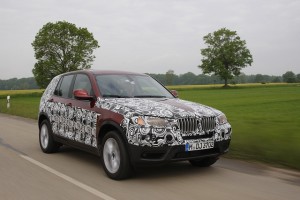After a six-year production run, BMW is finally ready to replace the X3 SUV. When it first appeared in 2004, the X3 was the German firm's smallest off-roader, but times have changed and it's since been undercut by the dinky X1 and outdated by the more advanced X5 and X6.
We were let loose in a pre-production mule, which isn't quite the finished article. Save for the generous amounts of camouflage and a few low rent bits of interior plastic that BMW assures us won't be seen dead on the final model, the car that we drove is pretty much what you'll get in the showroom come November.
In the Metal
With the psychedelic black and white camouflage splashed all over the bodywork, it's difficult to get a proper feel for what the latest X3 really looks like. What we do know is that the changes are much more than a simple mid-life facelift. The X3 is bigger in every direction; it's 79mm longer and 28mm wider, which translates into a seriously roomy interior.
There's more headroom, extra space between the driver and the passenger and a further 23mm of legroom in the rear, which might not sound like much, but it seems huge from the back seat.
Beneath the cladding, it's clear that the X3 has been brought up-to-date with the rest of the range. The squared-off headlamps and cleaner lines give it a much tidier look than that of the current model. We'll know more when the disguise comes off and it's officially unveiled at the Paris Motor Show in September.
What you get for your Money
Prices have yet to be announced for the Irish market, but it's a safe assumption that the new X3 will cost roughly the same as the outgoing version but with a slight price increase that is typical of an updated model. Expect a starting price somewhere in the region of €45,000 depending on the final emissions figures.
The standard equipment list should be pretty generous, though. Front and rear parking sensors, cruise control, automatic air conditioning, an iDrive controller and display and leather seats are all included in the asking price. Notable options include an eight-speed automatic gearbox, electronic damper control, a panoramic glass roof, a satnav/multimedia system and a head-up display. No word yet on how much these extra goodies will cost.
Driving it
One of the biggest criticisms of the previous X3 was its appalling ride quality. BMW thought that a sporty edge would go down well with trendy young buyers, but the engineers took things a little too far and made the suspension so firm that it was debatable as to whether the car had any.
BMW wisely allowed us to drive to the test area in a current X3 before we tried the new one. The smooth German roads didn't really show up the car's poor ride, but the occasional undulation sent an unwelcome shudder through the cabin. The old car also seemed tremendously outdated and more at home on a second-hand forecourt than in a Beemer showroom.
It could have been the huge contrast between the two cars that swung it, but the new X3, fitted with the 185hp 2.0-litre '20d' engine was crisp and responsive. The engine is smooth and its power delivery more linear, while the optional eight-speed automatic gearbox made its way through the cogs with little fuss.
The ride is much improved - a wider track and improvements to the chassis have taken care of that - which proves that BMW has listened to its customers. The steering is heavier, especially in Sport mode. There's more weight and liveliness to it than there ever was in the old X3 and smaller steering inputs go further.
Worth Noting
Despite its increased size, the new X3 is actually 25kg lighter than its predecessor. BMW has used aluminium in various places around the car to shave off those extra pounds.
That also helps to improve fuel economy, which is up by 15 percent on the diesel engines that are bound for Ireland (there are currently no plans to bring a petrol X3 to our shores). All new X3s get BMW's eco-friendly EfficientDynamics treatment, which includes stop-start technology (even on the auto) and brake energy recovery.
Summary
BMW's new X3 is miles better than its predecessor - but it ought to be, as the company has had plenty of time to get it right. What's interesting is that the additional size, space inside and practicality (the boot is now up to 550 litres with the rear seats up - an improvement of 70 litres) could potentially encroach on X5 territory.
The X3 20d is far more economical than any X5 though; it uses 5.6 litres/100km (50.4mpg) with the automatic gearbox and 5.7 litres/100km (49.6mpg) as a manual. The 30d, due on sale in 2011, isn't much thirstier, but it packs 260hp, 280lb.ft of torque and takes only six seconds to reach 100km/h. Add to that the fresh looks and great packaging and there's little case for buying an X5.

